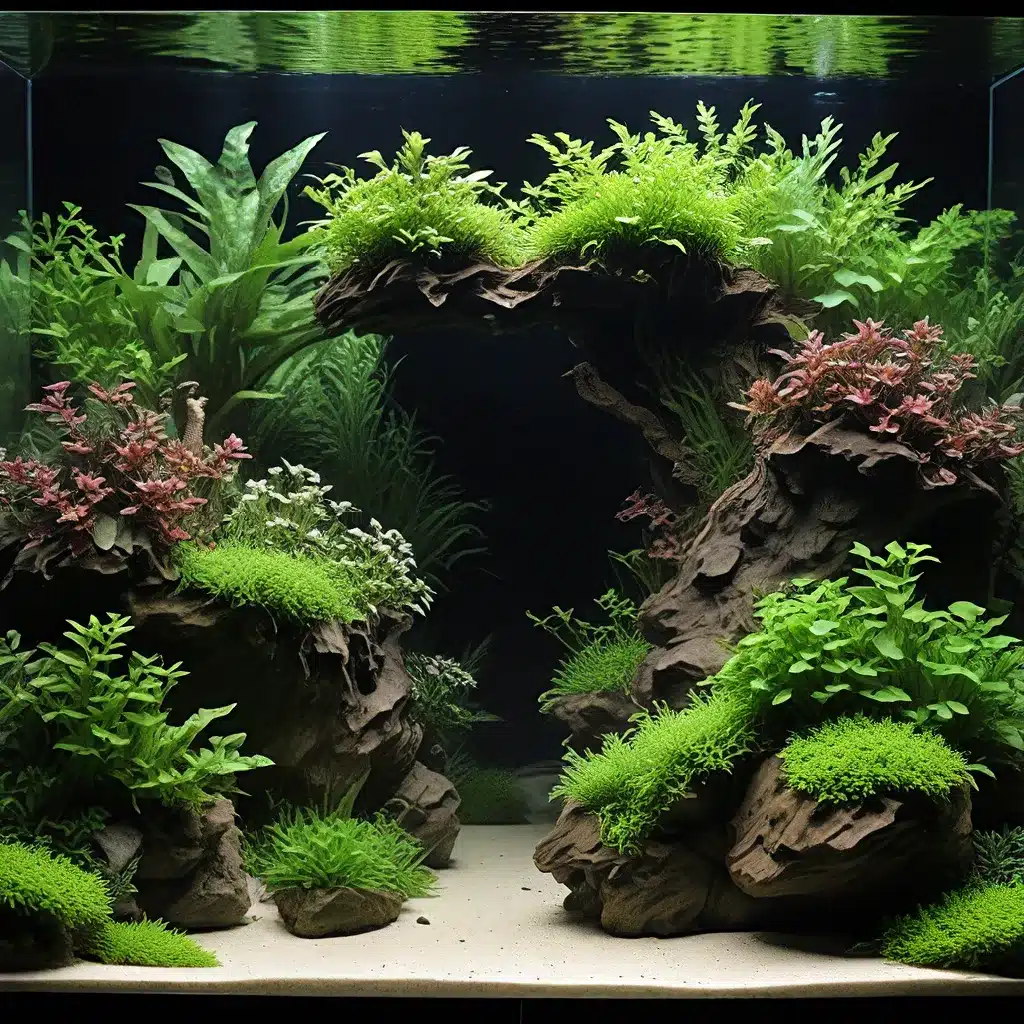
Aquarium enthusiasts have long been fascinated by the art of aquascaping, the process of meticulously designing and maintaining an underwater landscape within their tanks. Traditionally, aquascapers have relied on natural materials like rocks, driftwood, and a variety of aquatic plants to create stunning, nature-inspired scenes. However, in recent years, a growing number of hobbyists have been exploring the use of more unconventional materials to elevate their aquascaping designs, pushing the boundaries of what’s possible in the underwater world.
Unlocking Creativity with Unconventional Aquascaping Materials
One of the key benefits of incorporating unconventional materials into aquascaping is the opportunity to create truly unique and visually striking setups. By thinking outside the box and experimenting with unexpected elements, aquascapers can differentiate their tanks from the mainstream and showcase their individuality.
For example, some aquascapers have begun incorporating man-made materials like metal, glass, or even ceramics into their aquascapes, leveraging the contrast and texture these elements can provide. Others have explored the use of reclaimed or repurposed objects, such as discarded industrial components or vintage trinkets, to create unexpected and visually captivating scenes.
The integration of these unconventional materials not only enhances the aesthetic appeal of the aquarium but also challenges the traditional notions of what an aquascape should be. By embracing a more avant-garde and experimental approach, aquascapers can tap into their creative potential and inspire others to push the boundaries of this art form.
Balancing Functionality and Aesthetics
While the allure of using unconventional materials in aquascaping is undeniable, it’s crucial to strike a delicate balance between aesthetics and functionality. Aquascapers must carefully consider the impact these materials may have on the overall health and stability of the aquarium ecosystem.
One crucial factor to consider is the compatibility of the materials with the aquatic environment. Some materials, such as certain types of metals or plastics, may release harmful substances into the water, disrupting the chemical balance and endangering the well-being of the inhabitants. Aquascapers must thoroughly research the properties and potential impacts of any unconventional materials they wish to incorporate, ensuring they do not compromise the fundamental requirements of a thriving aquarium.
By carefully evaluating the functionality and compatibility of unconventional materials, aquascapers can ensure their designs not only look visually stunning but also maintain a healthy and thriving ecosystem within the aquarium.
Sustainability and Environmental Consciousness
As the aquascaping community continues to push the boundaries of creativity, there is also a growing emphasis on sustainability and environmental consciousness. Many aquascapers are now exploring the use of recycled, reclaimed, or repurposed materials in their designs, minimizing the environmental impact** of their hobby.
For instance, some aquascapers have found innovative ways to incorporate discarded industrial components, such as old pipes, valves, or machinery parts, into their aquascapes, transforming these once-discarded items into stunning centerpieces. Others have turned to natural materials like stone, driftwood, and even repurposed ceramics to build their underwater landscapes, minimizing the reliance on new, resource-intensive materials.
By embracing sustainable practices, aquascapers not only contribute to the preservation of natural resources but also inspire others to adopt a more eco-conscious approach to their own aquarium setups. This shift towards sustainability not only benefits the environment but also aligns with the fundamental principles of aquascaping, which seek to recreate and maintain a delicate balance within the aquatic ecosystem.
Unleashing Creativity through Aquascaping Workshops and Competitions
As the popularity of unconventional aquascaping continues to grow, aquarists and hobbyists have increasingly sought out opportunities to learn, share, and be inspired by the work of their peers. One of the primary avenues for this exchange of ideas and techniques has been through aquascaping workshops and competitions.
Through these collaborative and educational experiences, aquascapers gain a deeper understanding of the art of aquascaping, learning to balance aesthetics, functionality, and environmental considerations in their designs. The exposure to diverse perspectives and approaches also inspires them to continue exploring and refining their own techniques, further advancing the field of unconventional aquascaping.
Diving into the World of Unconventional Aquascaping
As the aquascaping community continues to evolve, the embrace of unconventional materials and design approaches has become a driving force in pushing the boundaries of this captivating art form. By tapping into their creative potential and leveraging the unique properties of unexpected elements, aquascapers can create truly one-of-a-kind underwater landscapes that captivate and inspire both seasoned enthusiasts and newcomers to the hobby.
Whether you’re a seasoned aquascaper or just starting your journey, King Aquarium is here to support you every step of the way. Explore our wide selection of high-quality aquarium equipment, plants, and decorations to bring your unconventional aquascaping dreams to life. Embrace the beauty of the unexpected and unleash your creativity in the captivating world of aquascaping.

